The thought of starting an ecommerce profit machine gets everyone excited.
But very few people I speak with spend any time crunching numbers before they get started.
Profitability isn’t guru magic, its math.
And the first key equation is your break-even point. If you understand the math already, feel free to jump straight to the break even calculator.
Going in without calculating your break-even point will land you flat on your butt. About 80% of ecommerce businesses fail despite the massive opportunity on the internet.
And I think that stat is generous.
Success is more than having a product that fills a market void and a strong marketing plan.
You’ll need to know how much your business will need to sell before you can start making a profit.
That’s your break-even point. Knowing what it is will lower your risk effectively and allow you to plan your cash flow and other business expenses well for the future.
In this article, I’m explaining the break-even formula and how you can calculate it.
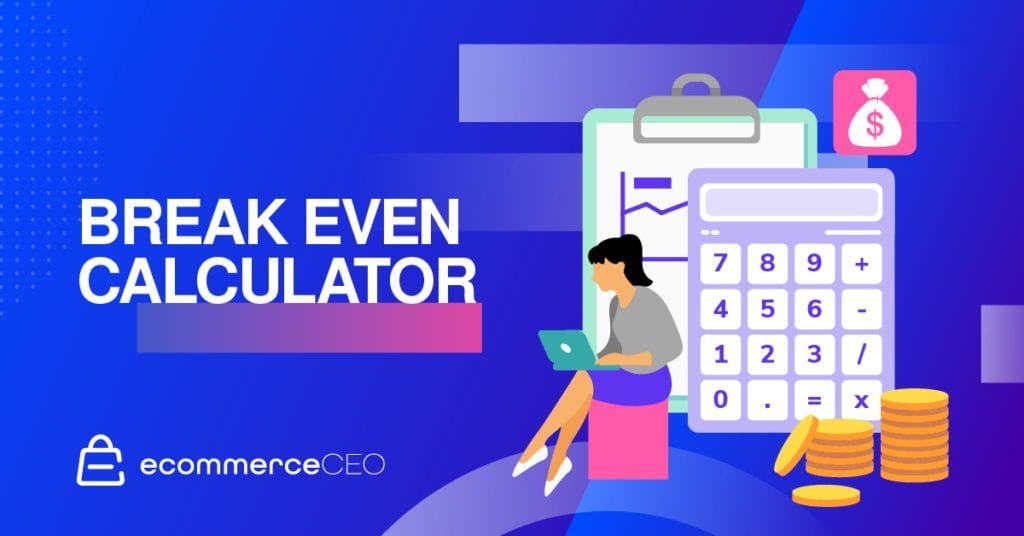
What Is Break Even Point
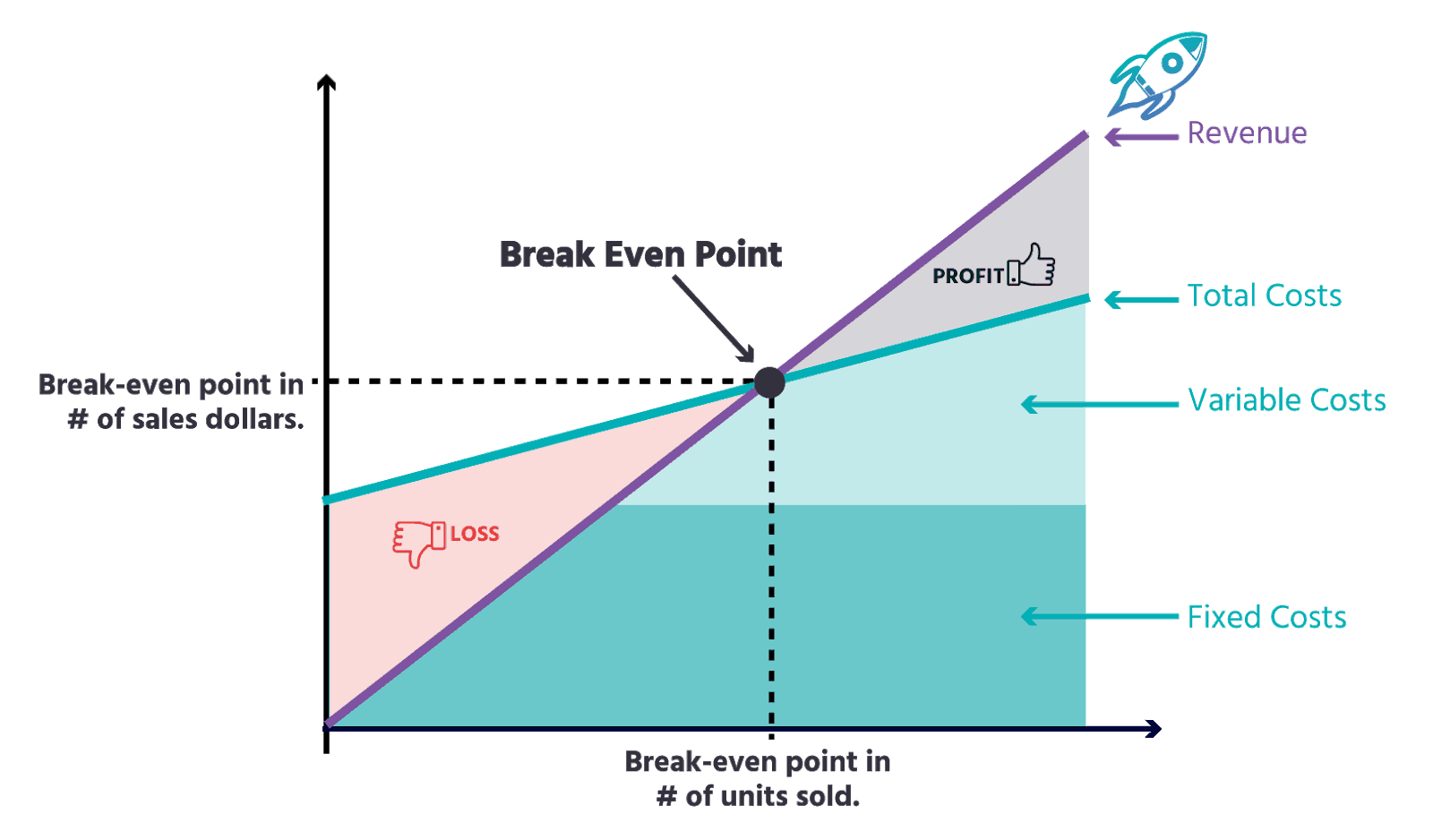
Your break-even point is the number of units you need to sell to get out of the red and achieve exactly $0 in profit.
When you’ve broken even, you’re not making profit nor loss. It’s that all your costs have been covered so that any more money you make from there is a part of your total revenues.
At the break-even point, your sales have covered your fixed and variable costs. Below it is a loss, above it is profit or your margin of safety.
It’s something that you have to calculate periodically because it doesn’t stay the same every month or year because the variable costs change.
Why You Should Calculate Your Break-Even Point
Doing a break-even analysis has many benefits for your business:
- It helps you know how long it will take before you make a profit and measure the profit and loss at different levels of sales and production. You can also use it to find out what effect a change in sales price will have on your profit.
- If you were selling a product that you bought from China at $8 for $30, you might think that your sales dollars is around $22.
- If you might jump in with that in mind, you’ll end up disappointed when $22 doesn’t show up in your bank account.
Knowing what price you can break even and how many products it will take will help you analyze your profit and know what to increase or cut out while still staying competitive. Also, it’s a part of your financial statements so you can see if your online business is growing year to year.
It’s also excellent to show anyone looking to invest money into your business that you have data so that they can understand just how profitable your idea will be with a quick estimate.
Break-Even Point Formula
The first thing you need to understand is the profit equation. The break-even formula is based on the profit equation where profit equals 0.
Profit = P(x) – VC(x) – TFC
- P is selling price (what you want to charge)
- X is the number of units bought and sold
- VC is your variable costs (cost of inventory)
- TFC is total fixed cost
Contribution margin P(x) – VC(x): measures the amount of incremental profit generated by selling an additional variable unit.
So let’s say you want to figure out your break-even point for selling a product that cost you $6 per unit that you are selling at $30. And you know your fixed costs to be $5,724.
We need to use a bit of algebra to figure out our break-even point. The first step is to set your profit at 0, the break-even point.
Profit = P(x) – VC(x) – TFC
0 = 30(x) – 6(x) – $5,724
24x = $5,724
X = 238
This tells you that you need to sell 238 units to make $0 – your break-even point.
How To Calculate Your Fixed Cost
Your fixed cost includes those things that stay the same regardless of what you sell. It doesn’t include inventory, but it covers your one-time start-up cost and monthly-fixed cost. They include:
- Business corporation set up
- Business license
- Domain name
- Logo and mood board
- Product descriptions and other branded content
- Photos
- Email copy
- Website theme
- Initial traffic and advertising costs
- Cross/up selling apps
- Marketing automation
Your total cost might have more things that what I’ve outlined. In Ecommerce CEO Business School 101, I’ve outlined start-up costs for you.
If you’ve already gone through the initial set-up cost, your monthly fixed cost is much lower. It’ll include just the cost of using your ecommerce platforms and apps.
How To Calculate Your Variable Cost
Your variable cost will include the costs of your product, inventory, and shipping. I have a product profitability calculator that can help you get your total variable costs per unit. You’ll need that because getting your variable cost is not as straightforward as your fixed cost.
To accurately hit the right end of the calculator, you’ll need to know the cost for the following:
Cost Of Product
The cost of the product is how much you are buying it from your supplier per unit.
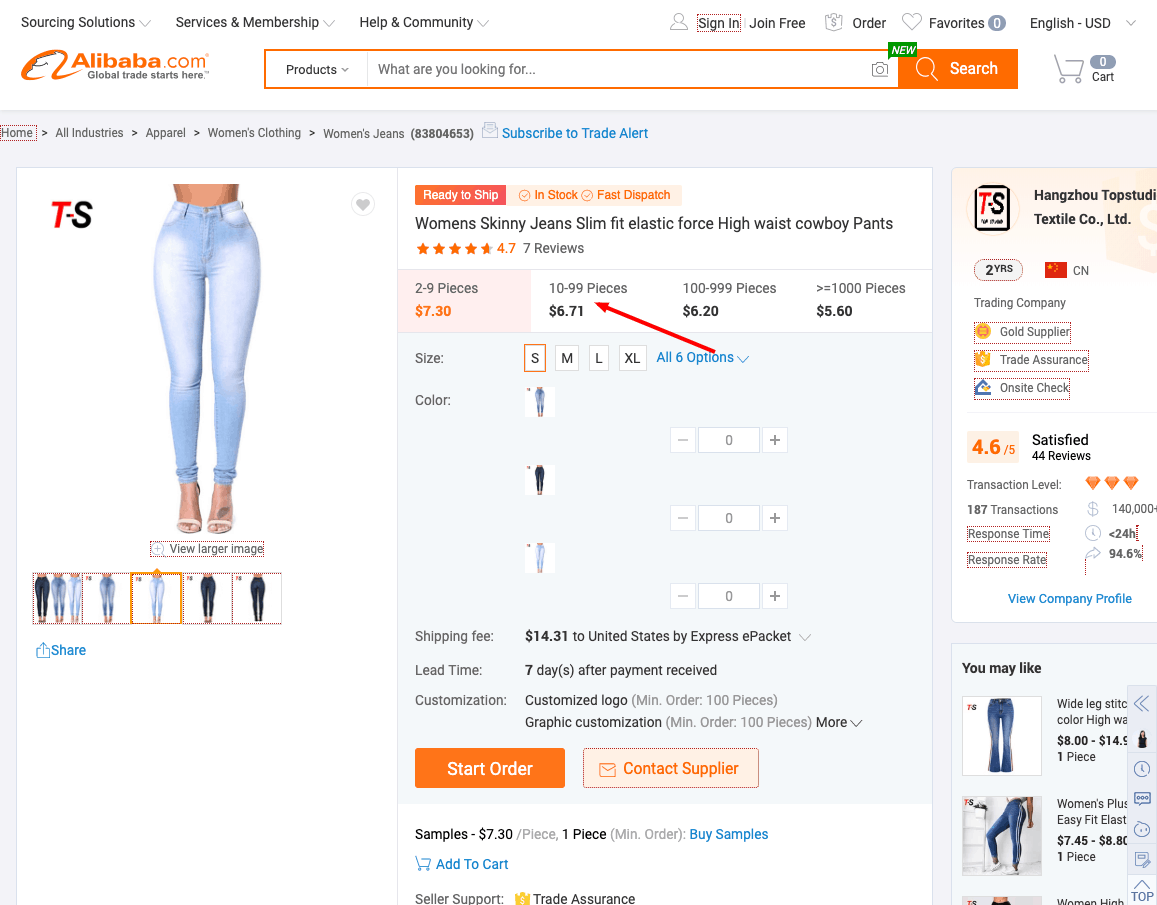
Using the screenshot above, if I was getting 80 pieces, the unit cost is $6.71.
Shipping From Supplier To You (or Amazon)
Your supplier will need to ship your products to you or a company that handles fulfillment and warehousing (you can use Amazon). If your supplier is shipping it to you first before you send it to Amazon, then the cost of sending it to your home/office plus Amazon is what you spend altogether.
You will have to contact your supplier to see what the shipping cost per unit is.
Import Duty Tax
If you’re shipping from overseas, you’ll pay duty. Use this duty calculator to determine that figure.
Amazon fulfillment
Amazon wouldn’t store your products and ship it to your customers for free. You’ll pay multi-channel fulfillment fees. Amazon has made that easy to know with this calculator.
Your exact product might not be on the Amazon store. If it isn’t, choose one that’s similar.
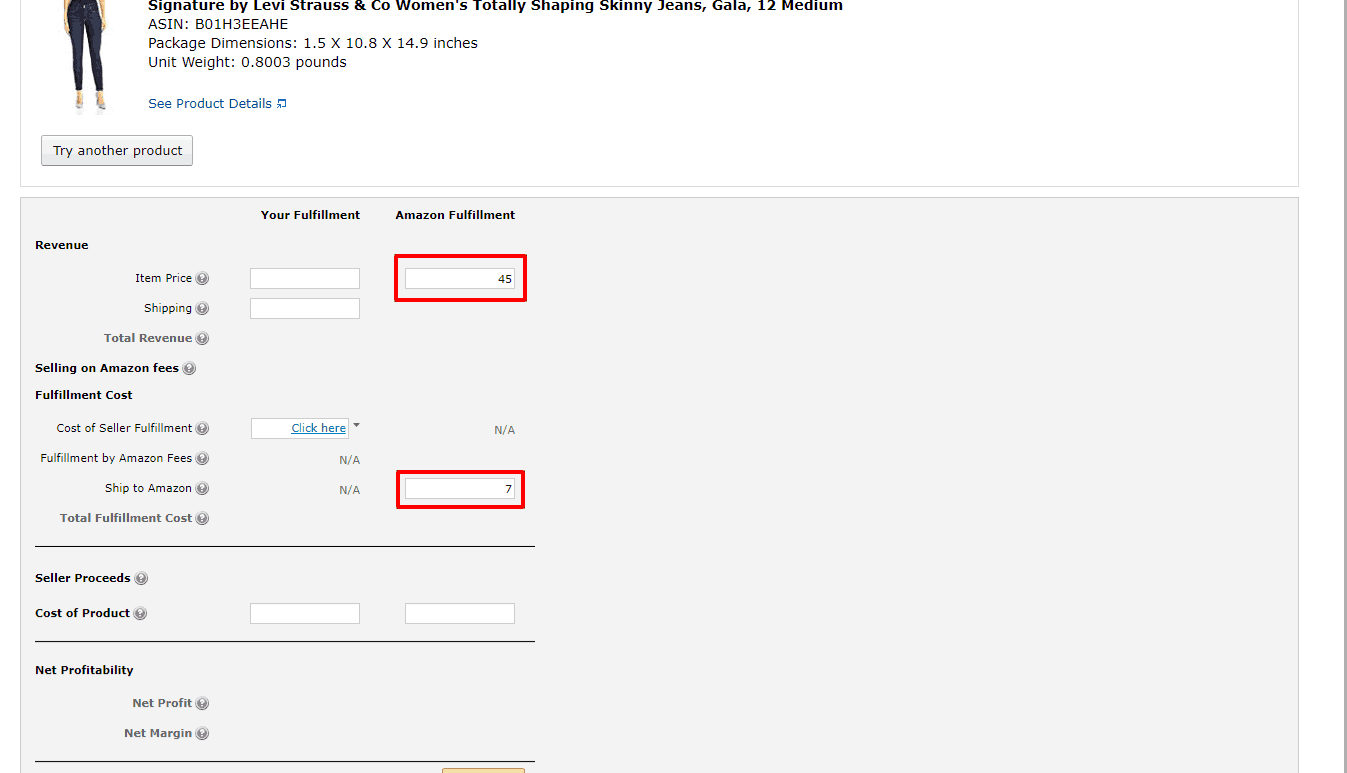
You don’t need to fill all the boxes because we’re not calculating your revenue but cost. So, put in the price you’re selling it to customers and the cost of shipping from your supplier to Amazon.
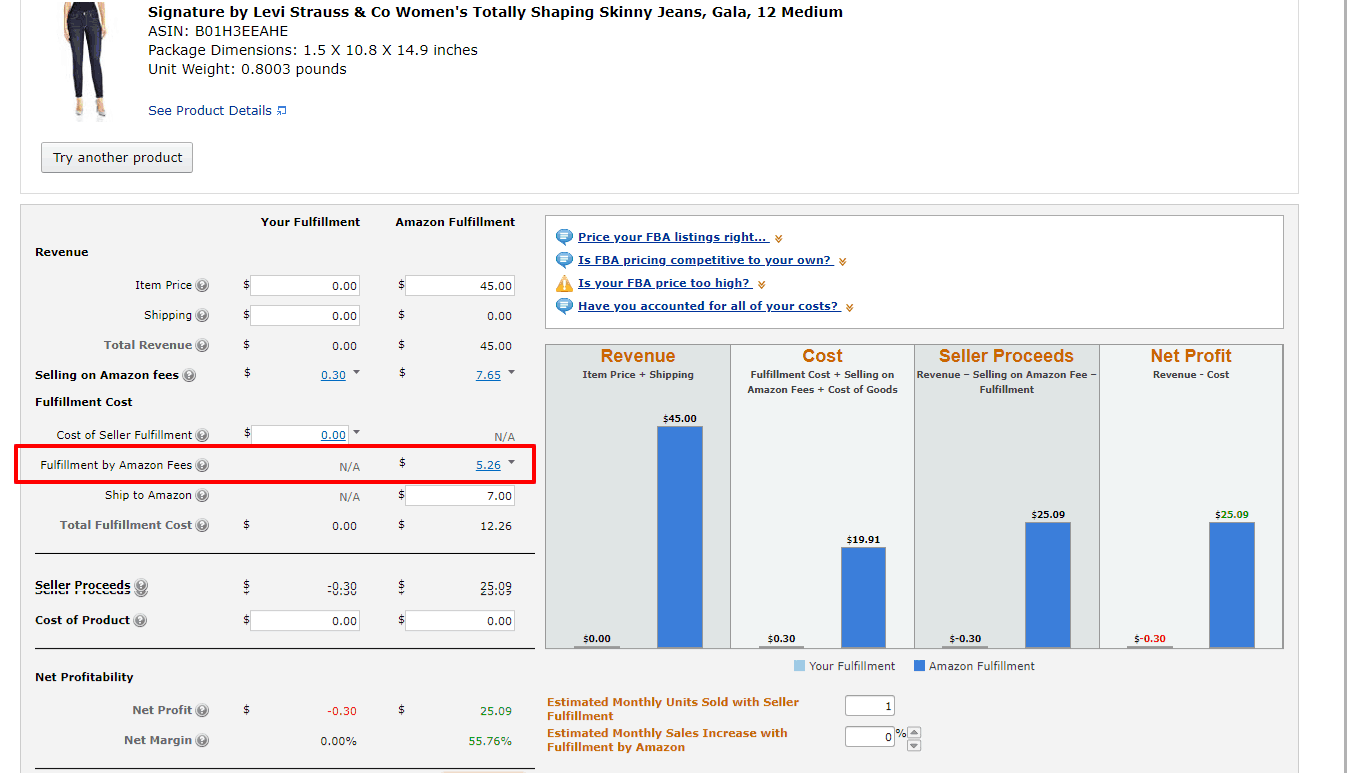
Ignore other figures in there for now. Pay attention to the one in red – Fulfillment by Amazon Fees. In our example, the cost of fulfillment and monthly storage is about $5.
Credit Card Fees
Most people ignore this figure even when they remember all others. That shouldn’t be because you’ll pay for it.
That’s usually around 2.9% plus $0.30 – it depends on your credit card processor. It could be higher or lower. You can check that out on the website of your payment gateway.
With all that in our product profitability calculator, we can see that our variable cost per unit of our skinny jeans is about $20.58.
If you take that out of the target sale price, then your contribution margin is $24.42 which is important to note down if you’re selling more than one product. It’ll show you the contribution margin ratio against your other products and know which is the profit leader so you can focus your marketing plans better.
Break Even Calculator
Now that we have our fixed cost and total variable cost per unit, we can get the break-even point.
Plug in all your figures, and the calculator will do the hard work for you.
The calculator does two things – tells you how many products you need to sell to break even and how many you need to sell to make your target profit.
For break-even, leave the target profit at $0. Input the total fixed costs that you calculated earlier. Then add in your target selling price per unit.
Your target selling price is how much you want to sell each unit of your product. When choosing your target price, ensure that you have at least a 40% margin after your variable cost.
With that and your total variable cost/cost per item, you’ll see the number of units that you need to sell in order to cover your expenses and break even.
If you’re producing and selling your products yourself, then you should factor in production cost to your break-even analysis formula. It isn’t fixed because that changes with your production volume, so you can add that to your variable costs.
Now, my calculator is very much focused on retail. Check out these other calculators:
- Break-Even Sales Analysis In Excel
- Break-Even Analysis – Harvard Business School
- Forecasting Calculator
The Formula For Success Lies In The Numbers
If you need to sell lots of units before you can break even, then you have to ask yourself if your business plan is realistic – should you raise the price? Find a way to scale down cost? Or choose more profitable products?
Regardless of if your number of units required to break even is five or 500, you’ll need a solid market strategy to get a profitable sales volume. Having a beautiful online store only wouldn’t do it.
Always keep a pulse on the numbers to ensure your business stays out of debt and your investment in ecommerce is a profitable one.









